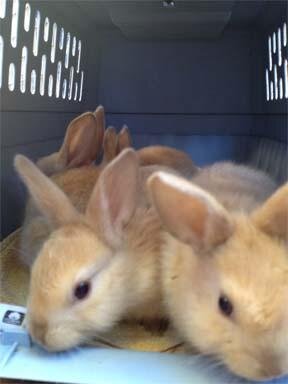|
Twenty-Five Years of BUNS: A No Kill Shelter
This year is the 25th anniversary of BUNS! We're celebrating by sharing stories from our volunteers about their experiences with BUNS. This month's story comes from long-time volunteer Jean Silva:
In 1992, when BUNS was founded, public shelters faced a population problem. Public shelters are open admission: they accept any stray animal from their service area. These shelters had only so many cages or kennels and only so many staff. So when the cages and kennels were full, the arrival of a new animal meant that another animal had to go. Of course adoptions were the best outcome, but when no other option was available, euthanasia was the answer. No kill shelters, in contrast, managed their populations by admitting a new animal only when space was available.
BUNS was different. We were an open admission no kill shelter. Our volunteers did not plan on euthanizing any healthy rabbit. Indeed many of our early volunteers began work at the shelter to save lives. So we did all the work, provided all the cages and hutches, and paid all the bills. When we ran out of space for rabbits, we found or bought another hutch; we moved rabbits into foster homes. As the number of rabbits at the shelter grew, we found new volunteers or worked harder. But, no matter what, we did not euthanize healthy rabbits.
Most weeks only one or two rabbits would come into the shelter. So all we had to do was keep a couple of cages open at all times. The challenge was to find space for groups of bunnies. Family groups could be housed in one hutch, but as the babies grew more space was needed. Fortunately the Long Run was donated. It was bout 10 feet long, with an enclosed cage at one end and the remaining 7’ as a fully enclosed wire run.
In 2001 our newsletter reported: “On Wednesday December 28th, BUNS received 19 Agouti rabbits. Many of these poor little souls had sore paws, and two of them required extensive medical attention for jaw abscesses and GI blockage. Another one, named Gino, just decided he did not like this whole thing and stopped eating. Thanks to the quick response of all our volunteers we have been able to shelter them all. All of them are making full recoveries. Now we are on the lookout for good homes for all of them.” After this, we began to collect cages.
A local research facility that went out of business donated 19 small rabbit cages. Mostly the cages were stored. But in an emergency they could be used as temporary housing. Rabbits could stay there until a foster home or a larger cage opened.
During the Jesusita Fire in 2009, BUNS filled to the rafters. A BUNS foster home and a rabbit border had to be evacuated. One of our volunteers, Andrea, turned her backyard into a bunny refuge for our BUNS fosters. Meanwhile, evacuees were bringing their rabbits to the shelter. Jean, whose own fosters were evacuated to Andrea’s, spent the night at the shelter. Each time a new rabbit arrived, she would pull an emergency cage from storage. She set it on top of a hutch added a litter box, food and water. The shelter stayed open all night receiving dogs, cats and rabbits.
The next morning BUNS volunteers appeared without being asked. Everyone worked extra shifts: checking new rabbits, trimming nails, cleaning and feeding. Our wonderful volunteers kept this up until people were able to return to their homes and claim their bunnies.
And so it goes, once every one or two years we get a large group of rabbits. Overnight the shelter population can double. Our last big group was the Christmas rabbits. Twenty eight rabbits arrived in December 2013. We still have 12 of this group at the shelter.
When the next fire happens. When the next family whose breeding got out of control arrives, BUNS will be there for you and for the rabbits.

|